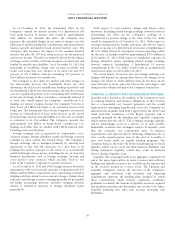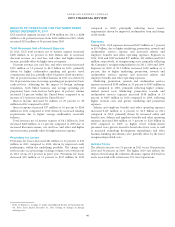American Express 2011 Annual Report Download - page 45
Download and view the complete annual report
Please find page 45 of the 2011 American Express annual report below. You can navigate through the pages in the report by either clicking on the pages listed below, or by using the keyword search tool below to find specific information within the annual report.
AMERICAN EXPRESS COMPANY
2011 FINANCIAL REVIEW
Calculation of Net Interest Yield on Cardmember
Loans
Years Ended December 31,
(Millions, except percentages
and where indicated) 2011 2010 2009
Net interest income $ 878 $ 965 $ 1,082
Average loans (billions) $8.8$ 8.6 $ 8.9
Adjusted net interest income $ 855 $ 946 $ 1,087
Adjusted average loans (billions) $8.6$ 8.5 $ 8.9
Net interest income divided by
average loans 10.0% 11.2% 12.2%
Net interest yield on cardmember loans 9.9% 11.1% 12.2%
RESULTS OF OPERATIONS FOR THE THREE YEARS
ENDED DECEMBER 31, 2011
ICS reported segment income of $723 million for 2011, a $186
million or 35 percent increase from $537 million in 2010, which
increased $207 million or 63 percent from 2009. The increase in
segment income for 2011 is primarily due to an increase in total
revenues net of interest expense and a decrease in provisions for
losses, partially offset by an increase in expenses. A significant
portion of ICS segment income in 2009 is attributable to the
Company’s internal tax allocation process. See further discussion
in the Income Taxes section below.
Total Revenues Net of Interest Expense
In 2011, ICS total revenues net of interest expense increased $596
million or 13 percent to $5.2 billion compared to 2010 due to
higher discount revenue, net card fees and other, partially offset
by lower interest income.
Discount revenue, net card fees, and other increased $683
million or 19 percent to $4.4 billion in 2011 compared to 2010,
primarily driven by a 15 percent increase in billed business and
the inclusion of Loyalty Partner’s revenues following the closing
of the acquisition in the first quarter of 2011. The 15 percent
increase in billed business in 2011 reflected a 15 percent increase
in average spending per proprietary basic cards-in-force.
Assuming no changes in foreign currency exchange rates from
2010 to 2011, billed business and average spending per
proprietary basic cards-in-force both increased 9 percent;
volumes increased across the major geographic regions,
including an increase of 10 percent in Latin America and
Canada, 9 percent in Japan, Asia Pacific and Australia, and 7
percent in Europe, the Middle East and Africa4.
Interest income declined $89 million or 6 percent to $1.3
billion in 2011 compared to 2010, primarily reflecting a lower
yield on cardmember loans, partially offset by slightly higher
average loans.
Interest expense of $426 million in 2011 was flat compared to
2010, as lower average loan balances offset higher average
receivable levels.
4Refer to footnote 1 on page 21 under Consolidated Results of Operations for
the Three Years Ended December 31, 2011 relating to changes in foreign
exchange rates.
Total revenues net of interest expense of $4.6 billion in 2010
was $119 million or 3 percent higher than 2009 due to higher
discount revenue, net card fees and other, partially offset by
lower interest income.
Provisions for Losses
Provisions for losses decreased $124 million or 32 percent to
$268 million in 2011 compared to 2010, primarily reflecting
lower reserve requirements due to improving cardmember loan
and charge card credit trends, partially offset by increased charge
card provision expense driven by higher average receivable
balances. The charge card net loss ratio (as a percentage of
charge volume) was 0.15 percent in 2011 versus 0.24 percent in
2010. The lending net write-off rate was 2.7 percent in 2011
versus 4.6 percent in 2010.
Provisions for losses decreased $819 million or 68 percent to
$392 million in 2010 compared to 2009, primarily reflecting
lower reserve requirements due to improving cardmember loan
and charge card credit trends.
Expenses
During 2011, ICS expenses increased $547 million or 15 percent
to $4.2 billion compared to 2010, due to higher marketing,
promotion, rewards and cardmember services and increased
salaries and employee benefits and other operating expenses.
Expenses in 2011, 2010 and 2009 included $36 million, $19
million and $4 million, respectively, of reengineering costs,
primarily related to the Company’s reengineering initiatives in
2011, 2010 and 2009. Expenses in 2010 of $3.7 billion were $620
million or 20 percent higher than 2009, due to higher marketing,
promotion, rewards and cardmember services and increased
salaries and employee benefits and other operating expenses.
Marketing, promotion, rewards and cardmember services
expenses increased $245 million or 15 percent to $1.9 billion in
2011 compared to 2010, primarily due to greater volume-related
rewards costs and co-brand expenses and the inclusion of Loyalty
Partner following the closing of the acquisition in the first
quarter of 2011. Marketing, promotion, rewards and
cardmember services expenses increased $391 million or 32
percent to $1.6 billion in 2010 compared to 2009, primarily due
to higher marketing and promotion expenses and greater
volume-related rewards costs.
Salaries and employee benefits and other operating expenses
increased $302 million or 15 percent to $2.4 billion in 2011
compared to 2010, reflecting the inclusion of Loyalty Partner
expenses following the closing of the acquisition in the first
quarter of 2011, as well as increased salary and benefit costs.
Salaries and employee benefits and other operating expenses
increased $229 million or 13 percent to $2.1 billion in 2010
compared to 2009, reflecting the higher net reengineering costs
in 2010, higher technology development expenditures, increased
investments in sales-force, closing costs related to the acquisition
of Loyalty Partner and other business building investments.
43
























